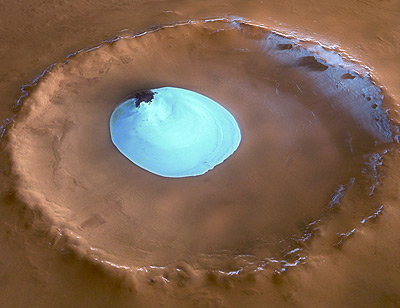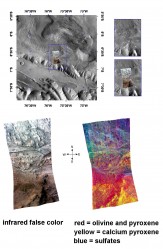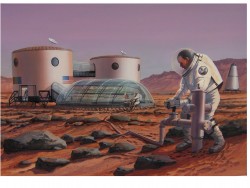New results from the The Compact Reconnaissance Imaging Spectrometer for Mars (CRISM) on board the Mars Reconnaissance Orbiter (MRO) reveal the mineral composition of the bottom of Chandor Chasma. There is a rich mix of sulfate and pyroxene-containing deposits in this region and the CRISM instrument continues to find deposits of minerals never thought to exist on the planet’s surface. However, the primary mission objective is to find evidence of water, past and present, aiding the hunt for the best location of the first Mars settlements. SETI Institute principal investigator and CRISM scientist Dr Adrian Brown answers some of my questions about CRISM and how the results may be useful for future manned missions to the Red Planet…
Part of my duties as Communications Officer with the Mars Foundation (a non-profit organization for Mars settlement designers) is to contact and interview key mission scientists working on missions that could be useful for getting us closer to realising the first manned settlement on the Red Planet. Dr Adrian Brown is one such scientist; the CRISM instrument is one such mission. CRISM, an advanced spectrometer, has been looking out for the mineral fingerprint of water since 2006. Minerals will have dissolved in ancient liquid water, so looking for the dry remnants of these minerals today will help to reveal the surface conditions of the past. Another mission objective is to characterize present water on Mars, seeing how surface water ice forms and how it varies with the seasons. Dr Brown’s current project is to map the seasonal variations of water ice in the Martian southern polar region.
In a timely news release, the CRISM mission site has announced new results to come from the analysis of the mineral distribution at the bottom of Candor Chasma (pictured), part of the vast Valles Marineris. Candor Chasma is a deep, long and steep-sided valley about 813 km (505 miles) long and has been cited as a possible location for the Hillside Settlement concept as conceived by the Mars Foundation. In fact, this settlement concept was the inspiration behind the first permanent settlement aptly called “Underhill” in Kim Stanley Robinson’s epic novel Red Mars. So, there is obvious interest as to what Candor Chasma can offer the colonists inhabiting the Hillside Settlement with easy access to locally mined minerals.
The CRISM instrument has discovered quantities of sulfate and pyroxene rich deposits in the region, useful for many industrial processes. In our interview, Dr Brown outlined other important minerals that CRISM has found and some of their common uses here on Earth:
“These [minerals] include kaolinite (chinaware is made of this mineral), talc (the main constituent of many soaps) and hydrated silica (perhaps like chert, which Indian knives were carved out from). The small amounts of these minerals means it has been impossible to discover them before CRISM, and previously they were discounted in all our modelling of Mars.” – Dr Adrian Brown, SETI Institute principal investigator and CRISM scientist.
For me, the most revealing part of our conversation was Brown’s estimate on the sheer quantity of water held as ice in the north polar cap. The north pole hides under a 1000 km (620 mile) diameter disk of near-pure water ice (with some impurities like sand and dust, giving a pink hue). This disk is 3 km (1.9 miles) high, holding staggering 2.35 million cubic kilometers of water. That’s enough water to cover the continental US to a depth of 200 meters! Throw in the water that is held at the south pole (a carbon dioxide/water ice disk 300 km in diameter and 2 km high) and we’re looking at the equivalent volume of water ice held in the Greenland ice sheet (or 500 times less than the amount of water in our oceans). It’s not that hard to imagine that if a permanent Mars colony is established, mining operations for water ice would be common.
But it doesn’t stop there; water could also be extracted from the atmosphere. One of Dr Brown’s studies focus on measuring the variation of water ice crystals in the clouds throughout the seasons. There should also be quantities of water vapour in the warmer equatorial regions.
There is also the possibility of extracting water from the permafrost layers below the Martian regolith. The Phoenix Mars lander (set to arrive at the Red Planet on May 25th) will be able to investigate the possibility of sources of frozen water below the surface. Dr Brown also indicated that the observations by the Mars Orbital Camera (on board NASA’s Mars Global Surveyor, lost in November 2006) of apparent gullies may reveal the location of possible sub-surface aquifers (after gushing across the surface) for future colonists to “tap” into (pictured). However, there have been studies that dispute this in favour of dry debris flows creating the gullies, but a definitive answer will not be arrived at until the gullies are analysed in-situ. And if he had the chance, I think Dr Brown would be the first to look into this exciting possibility after I asked him the question: Would you like to go to Mars?
“Of course I would love to travel to Mars, most of all to go to the polar regions and observe them with my own eyes. If I could actually go to the surface of Mars to investigate the fascinating geology of Nili Fossae and Valles Marineris, that would be so awesome. And to visit a gully site and dig behind it to try and find its source… and to witness the cold volcanoes of mud that erupt in the polar cryptic region during springtime… to go and understand these things that have us puzzled at the moment would be so amazing… and of course more questions would be raised, more geological problems unearthed, and the cycle of understanding the Red Planet would continue.” – Dr Adrian Brown
I share his enthusiasm and look forward to more discoveries by CRISM.
For more on Dr Adrian Brown’s work, check out his website: http://abrown.seti.org/
Sources: The Mars Foundation, CRISM




Posted this link in http://www.surfurls.com
What happened to the sagittarius nova? Or was it just a hoax/mistake?
I am sure that Kim Stanley Robinson also knew that “Underhill” was also a name that one Frodo Baggins of Bag End in the Shire of Middle Earth used in an earlier fictional epic. His home was in the side of a hill.
But it is good news to hear about the water on Mars! It will help, with the thin air, high radiation and severe cold. “Mars ain’t no place to raise a kid”.
Is CRISM able to tell if the minerals were a direct result of an impact and deposited from the meteroite or actually formed in the martian interior?
A very cool article. I watched Mars last night as it drew into a perfectly straight line with Pollux and Castor in Gemini. I hope we can land humans on Mars in my lifetime.
Peter Brouwer is correct. However, he missed a major factor. The return on billions of dollars of investment. Mankind will eventually get a research team on the surface of Mars. Colonization? I doubt that will happen in this century.
Air, water, sunlight, put this on the Moon and we would be one step closer to getting to the stars. We have to do it eventually, we should start now.
According to NASA (if I recall correctly), if all the ice on Mars were to be melted, the planet would be covered – on average – in water to an 11 meter depth. So I’d imagine it will fill the canyons of Valles Marineris for example, but leave much of the Tharsis Bulge dry… I’ll need to get all the figures on this though and need to check my references….
The Dream is good but the money and will are lacking !
Going to mars? himm, not at $200,000.00 dollars per seat.
Lets face it, in 39 years the best mankind can do is to put up a few cans tied together into orbit for about 10 years. The shuttle fleet is set to be decommissioned in 2010, the I.S.S. is set to be decommissioned in 2015, and N.A.S.A. is not going to try landing man on the moon again untill 2020-2025. He might put a can on the moon by 2050, maybe put a can in orbit around the moon and call it a lunar station by 2075, and then maybe try to shoot for the Martian moons by 2100, then maybe,,,maybe try landing on Mars, IF, he can lift off and reach Mars orbit again. Oh! wait! this will cost trillions of dollars to do!! Some how with all the major budget cuts Congress has dished out to N.A.S.A already, I just don’t see this happening with in the next 100 years.
I just can’t see the craft, houseing, supplies, waste disposel, safety suits, etc, etc, being paid for buy Congress or the Corporate world. Why you may ask? Because theres something missing in space…..MONEY TO BE MADE.
Now, if you could build something out there to sell, like rental units for labs, at about 125-250,000.00 per month, and an affordable means of transportation for people and cargo after 2010, plus a resource of inexpensive supplies to ferry up from time to time, and return waste products, and cheap fuel costs, for about a fraction of that cost, then you might have something for hope.
Untill there is a population out there, Corporations like Burger King, Hilton hotels, and K-marts stores are just not going to be intrested in being there. There in is where our problem lays. There is no one to do buisness with out there. There is no known resource to be mined that would offer a reasonable profit yeild, so Exxon isn’t intrested eather.
Though Christopher Columbus wondered over here to find the New World, and Americans pioneered the great west, I don’t think there will be a pioneer to set sail to the Moon or Mars any time soon. Those sail boats cost to much to build by one country or person alone. Heck, Burt Rutan and Richard Branson together barely can make a craft to reach standard orbit with all their billions of dollers and pounds. Burt Rutans’ been working on this for the past 20 years too.
Maybe in another 100 years………Maybe.
Good one!
I’m curious: did anyone mathed it out to figure how much of Mars (and which parts) would be flooded in case all that water liquified?
(And yes, I know that we’d need a thick and warm atmosphere first. But I’m still curious)
Well, I got too curious, so I tried to come up with an approximation by myself. Lacking a proper altitude profile for Mars, though, I had to use a bump map and its colour histogram, which can only provide a very crude approximation, because it uses an equirectangular projection, which generates heavy distortions: pixels correspond to widely different areas around the planet. But still…
The numbers I got would mean that all the polar water would only fill most of Hellas Planitia and a few deeper craters up north. I’m pretty sure that the error is large, though, so if there is anyone out there with better numbers, shoot.
No money to be made in Space?? Potential is everywhere!! Mining will be the start.
It would be a sure bet that once Titanium – Magnesium – water ect. and other minerals are confirmed on the Moon and Mars that SOMEONE in the corporate world will be quick to finance a mining operation as soon as possible. It may take a few years to develope, but the only thing that is missing is the confirmation, and the process will begin before the ink dries on the article.
When water is found on the Moon, it won’t surprise me if someone wants to bring it back, even as costly and self defeating as that sounds.
Theres a Planet-full of greedy people down here.
We should use the minerals found to further our Space exploration though, and only for Space.
Has everybody forgotten about the lack of a magnetic field to protect the lives of the humans who go there from the cosmic radiation?
Unless Mars could be terra-formed into having an atmosphere compatible with human life what is the point? If we wanted to live in a place where we had to stay inside to survive we could either live in many of the major cities around the world, under the ocean or the poles.
Ray Bradbury would be proud.
Lets look at what has been accomplished in the last 100 years in science and engineering and then look at what many famous scientists and science advocates of the past have speculated would happen in the next 100 years.
Negative comments like “Humans will never fly in a aircraft” , “Rockets wont fly in the vacuum of space because there is nothing to push against in space ” and Paul Goddard is living a fantasy” and “there will only be maybe a thousand home computers ever in the world”.. sound familiar ?
It will only take a few major break throughs and pioneerin spirit to jump start the new systems needed to colonize space .
Nuclear or Lasar or some other new idea of propulsion are some and I can’t imagine the unknown others which may occur in the next 25 years even.
So I am only a gnostic/agnostic and will not stick my neck out and say anything is too difficult to implement in the near future… except maybe space elevators , but there I go again creeping towards being a “Nay Sayer” myself.
Wha?! 😮
Why on Earth (or on the Moon) would anyone want to spend gazillions of your favorite currency (seems to be the Euro these days) to bring down from the Moon something we have in huge quantities on Earth?! Something we’d probably end up needing to export to the Moon if ever a colony is established up there?!
Trust me: nobody is that crazy.
I’m actually rather sceptical about space mining industries, unless they are meant to provide raw materials for *space* endeavours. I could imagine that mining asteroids to send raw materials to orbital factories producing stuff that requires microgravity would be more cost-effective than sending those materials up from Earth, but I’m pretty much convinced that only in very peculiar situations would it pay to mine asteroids to send stuff down to Earth. We still have a long way to go in recycling before we even begin to exhaust most of our non-energetic resources.
Because our main problem is, and allways will be, energy. That’s the one thing we can’t recycle. Once spent, it stays spent. There’s no way around entropy.
A question was once asked ” Of what value is a new born baby?”. Learning/discovery is just like the new born. We will never know its value until done.
I am old enough to have experienced seeing the advances we as a people received from the offshoots of the space program from the 1950’s forward. All this time people kept saying “No value, no return on our tax dollars.” and when the many lifesaving and modern conveniences are produced for us from “these useless programs” nary a word of “I/we were wrong” was ever heard.”. So what value is there of a new born baby?
The one thing that might be brought back to earth is Helium3 from the moon
such amazing discoveries they have made
The idea of MARTIANAMERICANS.COM came to me on last December of 07 during a walk to starbucks coffee. The look of the main website was going to be different than what it is now. I was forced to build the website in two days before the launch date (Feb 1st 08) after a company in LA failed to deliver on time. The intention behind the idea is to cover planet earth and help the sick kids with leukemia. I hope you enjoy all the talent and the music of our friends. Yes, we will have many good days to come.
M-A MAN (SPACE & MUSIC FOREVER)